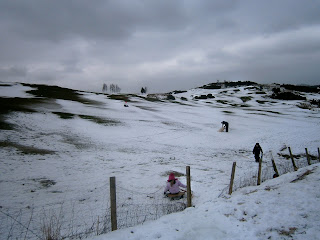Greyfriars Kirkyard, hauntingly mysterious, one of the most peaceful places in Edinburgh during the day yet at night taking on an almost supernatural atmosphere, encompasses Greyfriars Kirk and is the former site of a Franciscan friary. Burials have been taking place here for hundreds of years, and has a history played out amongst the vaults and tombs that have stood for centuries, silently revealing the stories of those buried beneath. Very much tied up with its past is the involvement of the Kirkyard with the history of the Covenanters. This movement began with the signing of the National Covenant in Greyfriars Kirk on 28th February 1638.

Following the defeat of the militant Covenanters at Bothwell Brig in 1679, some 1200 Covenanters were imprisoned in a field to the south of the kirkyard. In the 18th century part of this field was amalgamated into the kirkyard as vaulted tombs, and the area became known as the "Covenanters Prison."
 |
| The Black Mausoleum |
Perhaps one of the tales that most attracts visitors to this part of Edinburgh is that of Greyfriars Bobby, who allegedly guarded the grave of his master, police officer John Gray, famously sleeping there for thirteen years. The headstone of this devoted dog lies at the entrance to the kirkyard. Erected by the Dog Aid Society in 1981, it marks the actual burial place of Bobby in an unconsecrated patch of grass, a peculiarity which has led to more than a few misunderstandings and fictions surrounding his burial. Indeed, newer research suggests the whole story is a myth. So did Bobby the Skye terrier exist? Of course he did. And did he spend 13 years sleeping alongside his master's grave in the ultimate display of loyalty? I guess we may never, truly know, but it's a great story and one which I am sure will
continue to be debated for years to come.
Greyfriars Kirkyard is a macabre mix of enclosed vaults, tombstones and final resting places watched over by high stone walls and crumbling arches. Carvings straight out of a Hammer horror film look down from vantage points across this bewitching cemetery, carvings of skeletons, skull and
crossbones, and more than a few rather sinister-looking cherubs, casting a chill that at times cuts through the tranquility of the day. Two low ironwork cages, or mortsafes, can still be seen, recently restored, in the grass alongside the main path. These mortsafes were leased, protecting bodies long enough to deter the unwanted attentions of early 19th century "Resurrection Men" who supplied corpses to Edinburgh Medical College for dissection.
And so to ghosts and ghoulies. Greyfriars Kirkyard is one of the most haunted areas of Edinburgh, an achievement in itself in a city boasting countless spooks and spectres. Completely believable if you stand here when the mist is swirling around the gravestones, or darkness begins to cast its blanket of eerie silence. Perhaps the most renowned ghostly apparition is that of the infamous "Bloody" George Mackenzie, put to rest here in 1691. George Mackenzie was notorious for carrying out the policies of Charles II against the Covenanters. Ruthless to the end, he took an almost perverse delight in sentencing these people, and an even greater delight in their subsequent demise. The lucky were executed immediately, their heads displayed on the prison walls, whilst others were purely incarcerated and left to die in the Covenanters Prison. One of the more sinister buildings in the Kirkyard, the tomb of George Mackenzie, the Black Mausoleum, still stands today. In the late 1990's, a homeless gentleman suffering from overindulgence in a spirit of a different kind, is said to have disturbed and desecrated this tomb. His actions appear to have disturbed the spirit of "Bloody" Mackenzie from its slumber, and attacks on visitors have been reported ever since. He has never been seen, hence his labelling as a poltergeist, but his presence can be felt within the confines of the Covenanters Prison, where he no doubt feels anyone to be a valid target for his wrath. People have emerged with injuries they have no recollection of sustaining, including bruises, bites and scratches, as well as feeling strange sensations and sudden chills. The Prison is now only open to guided tours - safety in numbers, I guess. So do I believe in the Mackenzie Poltergeist? The whole kirkyard is often enveloped in patches of hot and cold air, eerie knocking noises can be heard, and there is without doubt a feeling of the unnatural and the unexplained. You can feel both a sense of calm and yet a sense of unease at the same time, but ghosts and poltergeists? Yes, why not ....... unless you can prove me wrong.

























